by Chris Millikan
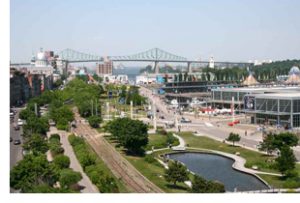 History buffs love sauntering along old Montreal’s cobbled European-style streets…or wandering her public squares surrounded by grand cathedrals, historic homes and museums.
History buffs love sauntering along old Montreal’s cobbled European-style streets…or wandering her public squares surrounded by grand cathedrals, historic homes and museums.
My hubby Rick and I recently join the curious throng and probe this cosmopolitan city’s earliest days.
At Musee Pointe-a-Calliere’s theatre, a multi-media journey through six centuries kicks off our exploration of Montreal’s birthplace between the St. Lawrence and Little St. Pierre Rivers.
This innovative three-story archaeological museum rises sleekly above the original town site where Paul de Chomedey and thirty-five French colonists settled in 1642.
A stroll through Fort Ville-Marie’s subterranean remains reveals traces of the early palisade, first Catholic cemetery, base of the old customs square…even experiencing the sights and sounds of a lively market day, circa 1750.
And from the third floor open-air Lookout, we view panoramic Vieux-Port’s busy quayside, nowadays a landscaped 2.5-kilometer-long linear park complete with flowers, sparkling water fountains and pools.
Nearby, Place Royale (now Place d’Youville) developed later atop Little Saint-Pierre River. Here a soaring granite obelisk recalls those plucky settlers beginning new lives on this strategic point of land at the foot of Mount Royal.
Two blocks away, an old fire station encloses Centre d’Histoire de Montreal, a small but charming museum reflecting city history through stories of celebrated personalities.
Northward along Rue St. Jacques, the sparkling Trade Center dwarfs sober financial institutions left from Montreal’s early financial Wall Street days, notably the Bank of Montreal, Canada’s oldest bank and the New York Life building, once North America’s tallest skyscraper at 10 stories.
Nearby we encounter Cathédrale Marie-Reine-du-Monde whose unexpected grandeur resembles Saint Peter’s in Rome. But here, patron saints of parishes grace the facade rather than apostles as on the famed Basilica.
And elaborate interiors reflect new world history, except for the marble altar canopy imitating Bernini’s work in St Peter’s. In the distance we spot McCord Museum, permanently chronicling Canada’s momentous past in McGill University’s oldest part.
Amid Place d’Armes, a central monument commemorates Montreal’s founders: Maisonneuve, who fought a battle here; Jeanne Mance, founder of Hotel-Dieu-de-Montreal, first hospital; trader and soldier, Charles Lemoyne; major Lambert Closse with his faithful dog Pilote and an unidentified Iroquois brave.
But the magnificent Basilica de Notre-Dame dominates this historic square, her spectacular interiors sculpted in wood and gold leaf. Inspiring stained glass windows illustrate biblical passages as well as parish history. And for over two centuries, seigneurs resided next door at St-Sulpice Seminary, still topped by a clock dating to 1701.
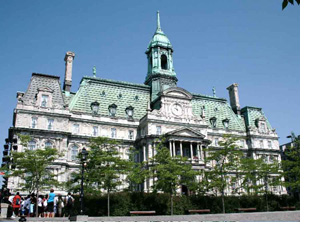 Stretching from Vieux-Port to Rue Notre-Dame, fine 19th-century townhouses and mansions surround Place-Jacques Cartier.
Stretching from Vieux-Port to Rue Notre-Dame, fine 19th-century townhouses and mansions surround Place-Jacques Cartier.
Though Admiral Nelson’s monument towers over this cobbled square, it carries the French explorer’s name. Once a large public market, Victorian streetlamps, tubs of red and yellow flowers, buskers and artists now create a lively ambience in this hillside square, day and night.
Along with locals and hoards of others, we toast Old Port’s panoramas from beneath flamboyant red awnings at one of its many sidewalk cafes.
At the top of the plaza, Hotel-de-Ville outshines a somber cluster of early courthouses.
From the grand balcony of this City Hall, French President General Charles de Gaulle once shouted, “Vive le Quebec libre!” causing quite a stir during his 1967 visit. Behind, we find remnants of a 6.4-meter high wall once stretching three kilometers around old town.
Across the street, Chateau de Ramezay awaits; attendants in ruffled blue dresses, white aprons and poke bonnets greet us.
Built in 1705 for Montreal’s Governor, 15 connecting rooms housed his family of 16 children. With remarkable 17th-century artifacts and furnishings this stone, peak-roofed mansion exemplifies the gracious lifestyle of its esteemed residents.
Behind the house we wander the French-style Governor’s Garden, tranquil and fragrant. Inspired by gardens at Versailles, this spot replicates former seigneurial gardens flourishing with fruit trees, flowers, vegetables and medicinal plants…but on a much smaller scale. “
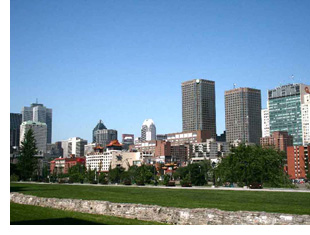 Then, everyone had gardens; large ones like this covered nearly two-thirds of the old fortified town,” explains the gardener, harvesting pungent chives, young carrots and emerald sprigs of parsley.
Then, everyone had gardens; large ones like this covered nearly two-thirds of the old fortified town,” explains the gardener, harvesting pungent chives, young carrots and emerald sprigs of parsley.
Within blocks, dramatized audiotapes guide us through another nineteenth century residence. Fashions and authentically restored, lavishly furnished interiors allow peeks into Sir George Etienne-Cartier’s influential life and glitzy high society of his day.
Fondly remembered as Father of Canadian Confederation, his considerable achievements also included creation of Quebec’s civil code and development of the Grand Trunk Railroad, all documented in his faithfully restored office.
Looping back, we pass Maison-de-Pierre Calvert from 1725, possibly the most photographed of all the heritage houses.
Currently a first rate inn and restaurant, striking wine-red doors and window frames contrast with massive grey rock walls, chimneys and steeply sloped roof.
The original homeowner collaborated with rebels during the American Revolution, holding clandestine meetings here with Ben Franklin, an envoy sent in 1775-76.
In the same neighborhood…and fondly nicknamed the Sailor’s Church, Montreal’s oldest chapel is immortalized in Leonard Cohen’s Suzanne.
Notre-Dame-de-bon-Secours has been a place of pilgrimage since 1665. Mariners believed the 10-meter rooftop Virgin Mary and her glorious angels safeguarded them at sea; some donated tiny ships in appreciation, many of which we notice hanging in the chapel.
Up 92 winding steps, we gaze over old town and harbor. Adjacent, Ecole Bonsecours school was replaced with a small museum chronicling first teacher Marguerite Bourgeoy’s life.
A leisurely walk westward takes us past silver-domed Marche Bonsecours, Montreal’s major agricultural market for over a century. Restored for its 150th anniversary, her long 100,000-square-foot limestone building has been re-established as a modern marketplace featuring specialty shops, exhibitions and sidewalk cafes…
By strolling Montreal’s historic streets and acquainting ourselves with early personalities, we’d traced the development of this little French fur-trading town into today’s happening metropolis.
About the author:
This week Traveling Tales welcomes freelance travel writer Chris Millikan who lives in North Delta, a suburb of Vancouver B.C.
About the photos:
1: Vieux-Port’s busy quayside. Rick Millikan photo.
2: Montreal’s old city hall. Chris Millikan photo.
3: Montreal’s old wall. Chris Millikan photo.
If you go:
- www.tourisme-montreal.org Tourism Montreal provides detailed information for all travel needs.
- www.bonaparte.com In the heart of the historic district, this jewel offers cozy rooms and out-of-this-world complimentary breakfasts.
- www.hotelxixsiecle.com A renovated1870 bank, this beautiful boutique hotel provides stylish rooms and comfort.
- www.borisbistro.com One of the old city’s most charming bistros offers great food with terrace seating.
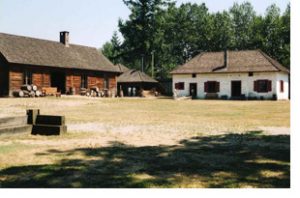
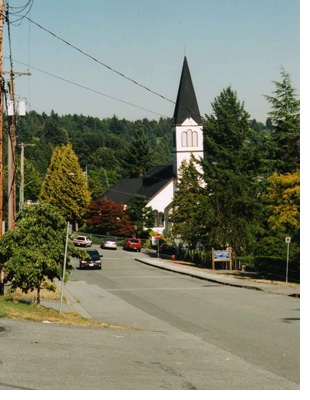 Lourdes, focused upon the mill and benefitted from its isolation in maintaining its unique French Canadian culture. It was not until the tidal swell of greater Vancouver pushed deeper inland that the culture integrity of the community began to be threatened. Yet the community persists and is experiencing a proud rebirth.
Lourdes, focused upon the mill and benefitted from its isolation in maintaining its unique French Canadian culture. It was not until the tidal swell of greater Vancouver pushed deeper inland that the culture integrity of the community began to be threatened. Yet the community persists and is experiencing a proud rebirth. Bright new Heritage Carre’ at Brunette and King Edward Streets houses Place Des Arts and the community Musee (museum) along with historical mementoes set in a pedestrian friendly environment. Bilingual interpretive signs dot the Maillardville area of Coquitlam and a colourful brochure, Maillardville Toujours,, complete with photos, provides for a self-guided walking tour of the old town.
Bright new Heritage Carre’ at Brunette and King Edward Streets houses Place Des Arts and the community Musee (museum) along with historical mementoes set in a pedestrian friendly environment. Bilingual interpretive signs dot the Maillardville area of Coquitlam and a colourful brochure, Maillardville Toujours,, complete with photos, provides for a self-guided walking tour of the old town.
 For a more serene glide down the mountainside alongside skiers and snowboarders, you can’t beat the Sno-Limo for comfort, ingenuity and convenience. Just a year old, the Sno- Limo is like a ski stroller for adults.
For a more serene glide down the mountainside alongside skiers and snowboarders, you can’t beat the Sno-Limo for comfort, ingenuity and convenience. Just a year old, the Sno- Limo is like a ski stroller for adults.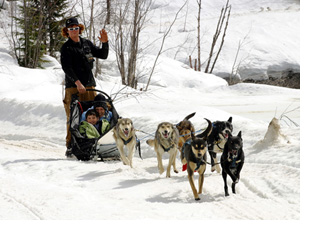 Some of the best ways to travel through the snow are those that have been around the longest-like dog sledding. Though not typically available in relatively warm climates like Whistler, local entrepreneur Bob Fawcett decided to give Whistler visitors a chance to experience this ancient form of transportation.
Some of the best ways to travel through the snow are those that have been around the longest-like dog sledding. Though not typically available in relatively warm climates like Whistler, local entrepreneur Bob Fawcett decided to give Whistler visitors a chance to experience this ancient form of transportation.
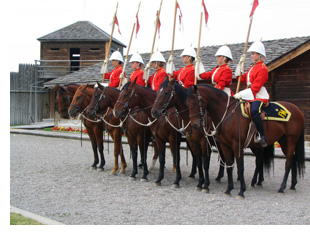 An arched walkway veered off Main Street, and led to The Fort Museum of the North West Mounted Police. Red-coated riders on sleek prancing steeds entered the grounds, their white pith helmets bobbing to the rhythm of “This land is your land, this land is my land….” My chest swelled with pride as we watched a musical ride performed by young equestrians, in replica uniforms of our Canadian icons.
An arched walkway veered off Main Street, and led to The Fort Museum of the North West Mounted Police. Red-coated riders on sleek prancing steeds entered the grounds, their white pith helmets bobbing to the rhythm of “This land is your land, this land is my land….” My chest swelled with pride as we watched a musical ride performed by young equestrians, in replica uniforms of our Canadian icons.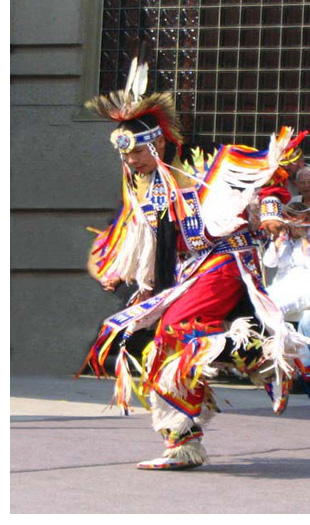 Head-Smashed-In Buffalo Jump is a short drive north and west of Fort MacLeod. We were greeted by resounding drum beats and the chanting of singers recounting 6,000 years of history. Nimble dancers dressed in beads, porcupine roaches and eagle feathers enacted ancient traditions to the delight of the audience.
Head-Smashed-In Buffalo Jump is a short drive north and west of Fort MacLeod. We were greeted by resounding drum beats and the chanting of singers recounting 6,000 years of history. Nimble dancers dressed in beads, porcupine roaches and eagle feathers enacted ancient traditions to the delight of the audience.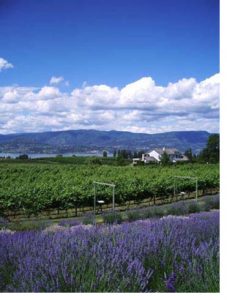
 Largest to be certified organic, Summerhill Pyramid Winery specializes in sparkling wines aged in a unique four-storey concrete Egyptian-style pyramid. Touring it, Casey reveals, “Facing true north, this fuse frame structure has no metals or electricity…but its spiritual energy positively affects liquids, proven in 14-year experiments and three years of taste-testing. Now, all our wines are pyramid-aged in this sacred geometry.”
Largest to be certified organic, Summerhill Pyramid Winery specializes in sparkling wines aged in a unique four-storey concrete Egyptian-style pyramid. Touring it, Casey reveals, “Facing true north, this fuse frame structure has no metals or electricity…but its spiritual energy positively affects liquids, proven in 14-year experiments and three years of taste-testing. Now, all our wines are pyramid-aged in this sacred geometry.”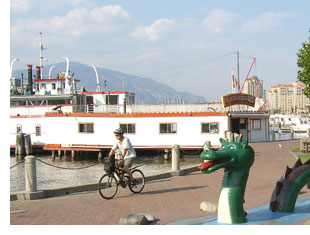 For a change of pace the next morning we join others sauntering…and cycling…along the restful lakeside walkway in Waterfront Park.
For a change of pace the next morning we join others sauntering…and cycling…along the restful lakeside walkway in Waterfront Park.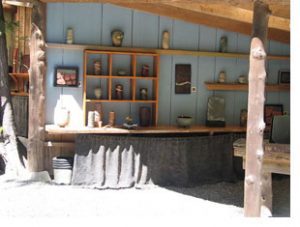 Just a puddle-jump away from the Lower Mainland, Galiano is magnificently undeveloped and pristine, its island charm unblemished by the tarnish of tourism.
Just a puddle-jump away from the Lower Mainland, Galiano is magnificently undeveloped and pristine, its island charm unblemished by the tarnish of tourism.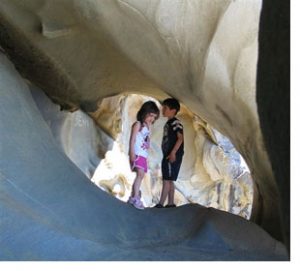
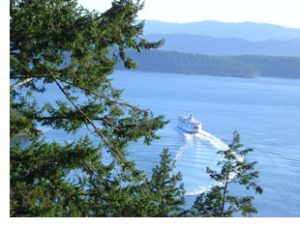 Part of it is the interesting cast of characters that constitute Galiano’s population. I caught a smattering of it on a quick visit. There’s Jane Rule, the well-known novelist whose work deals with gay and lesbianism, and Steve Ocsko, a Hungarian-born stone carver who lives and works up a steep hill on Manastee road, chiseling rocks into a veritable canvas of shapes and figures.
Part of it is the interesting cast of characters that constitute Galiano’s population. I caught a smattering of it on a quick visit. There’s Jane Rule, the well-known novelist whose work deals with gay and lesbianism, and Steve Ocsko, a Hungarian-born stone carver who lives and works up a steep hill on Manastee road, chiseling rocks into a veritable canvas of shapes and figures.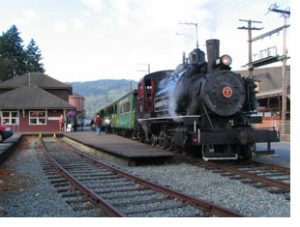
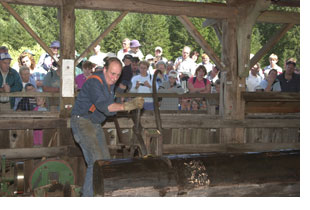 Troubadours roam the McLean Mill site bringing the Mill’s and Port Alberni’s long logging and sawmilling history to life. Close your eyes and the smell of freshly cut timber being hewn in a steam-driven mill will take you back to the early life-blood industry of Vancouver Island. The vibrant actors/musicians guide you through the mill as if you were just starting work there, touring the logging/sawmill camp buildings.
Troubadours roam the McLean Mill site bringing the Mill’s and Port Alberni’s long logging and sawmilling history to life. Close your eyes and the smell of freshly cut timber being hewn in a steam-driven mill will take you back to the early life-blood industry of Vancouver Island. The vibrant actors/musicians guide you through the mill as if you were just starting work there, touring the logging/sawmill camp buildings.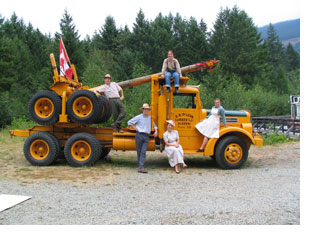 Port Alberni’s unique location at the end of the Alberni Inlet, or the Alberni Canal as locals call it, makes it a world-renowned place for salmon and halibut fishing. Also out on the canal, the MV Lady Rose or MV Frances Barkley can take you on an unforgettable 40 kilometer journey to Bamfield or Ucluelet with some of the most incredible scenery and wildlife viewing in the world.
Port Alberni’s unique location at the end of the Alberni Inlet, or the Alberni Canal as locals call it, makes it a world-renowned place for salmon and halibut fishing. Also out on the canal, the MV Lady Rose or MV Frances Barkley can take you on an unforgettable 40 kilometer journey to Bamfield or Ucluelet with some of the most incredible scenery and wildlife viewing in the world.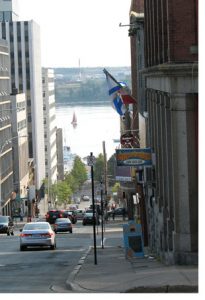
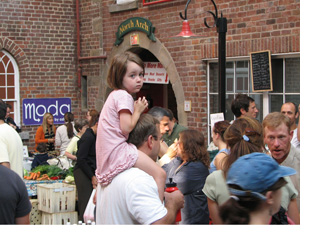 The market is a warren of rooms, passages, nooks and crannies. Stalls display Nova Scotian crafts—miniature watercolours of Halifax, stained glass candleholders glowing with Maritime emblems and designs, appliquéd aprons and eye catching pottery.
The market is a warren of rooms, passages, nooks and crannies. Stalls display Nova Scotian crafts—miniature watercolours of Halifax, stained glass candleholders glowing with Maritime emblems and designs, appliquéd aprons and eye catching pottery.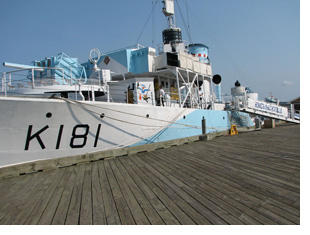 This is the HMCS “Sackville”, Canada’s last surviving vessel from a fleet of 269 gallant little corvettes that saw action in the Battle of the Atlantic during World War II. The boys nod attentively as their grandfather points out some of the ship’s special characteristics.
This is the HMCS “Sackville”, Canada’s last surviving vessel from a fleet of 269 gallant little corvettes that saw action in the Battle of the Atlantic during World War II. The boys nod attentively as their grandfather points out some of the ship’s special characteristics.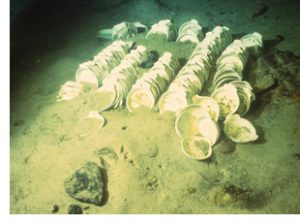
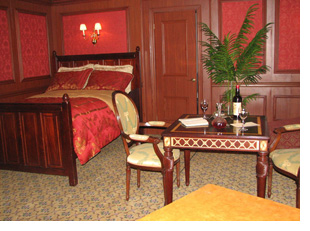 The artifacts recovered from the debris on the ocean floor range from perfume vials (visitors can sniff the scent) to one of the 3 million (possibly defective) rivets that held together the steel plates of the hull.
The artifacts recovered from the debris on the ocean floor range from perfume vials (visitors can sniff the scent) to one of the 3 million (possibly defective) rivets that held together the steel plates of the hull.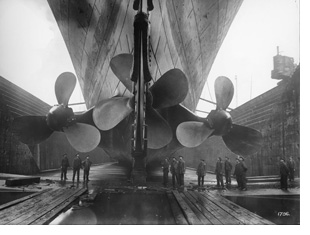 “There’s the excitement of constructing each of the artifact galleries, the ship’s grandeur, and the incredible drama of those final hours,” says Zaller, “but it’s the stories behind these one-of-a-kind irreplaceable objects that truly fire the imagination.”
“There’s the excitement of constructing each of the artifact galleries, the ship’s grandeur, and the incredible drama of those final hours,” says Zaller, “but it’s the stories behind these one-of-a-kind irreplaceable objects that truly fire the imagination.”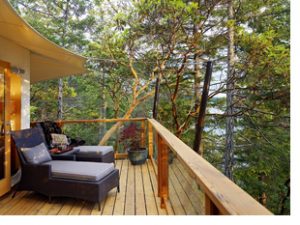
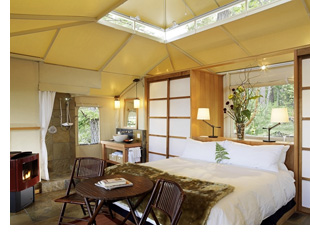 Inside the canvas walls of a 320-square-foot enclosure, expect slate floors with radiant heat, a Jacuzzi bathtub for two, flush toilets, a comfy king-size bed with down comforter and pumped up pillows and securely locked doors.
Inside the canvas walls of a 320-square-foot enclosure, expect slate floors with radiant heat, a Jacuzzi bathtub for two, flush toilets, a comfy king-size bed with down comforter and pumped up pillows and securely locked doors.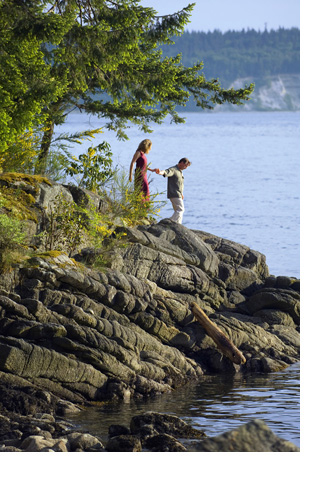 There’s no urgency to go anywhere once you arrive at Rockwater. A game of Scrabble, a good book and a pair of binoculars are all you need to pass the time.
There’s no urgency to go anywhere once you arrive at Rockwater. A game of Scrabble, a good book and a pair of binoculars are all you need to pass the time.